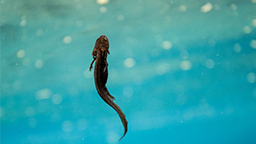In response to a legal petition from the Center for Biological Diversity, the U.S. Fish and Wildlife Service announced this week that the Crater Lake newt (also known as the Mazama newt) may qualify for protection under the Endangered Species Act.
The newts live only in Oregon’s Crater Lake and their populations have crashed in recent years due to the expansion of introduced signal crayfish and warming lake temperatures from climate change.
“Without endangered species protections this cute little newt will soon blink out of existence,” said Chelsea Stewart-Fusek, an endangered species attorney at the Center. “We need funding right now to remove signal crayfish from Crater Lake so these newts aren’t wiped out. Otherwise, this incredible lake will be changed forever.”
The Crater Lake newt is a subspecies of the more widely distributed rough-skinned newt. While the rough-skinned newt possesses a potent neurotoxin to deter predators, the Crater Lake newt is adapted to being at the top of the lake’s aquatic food chain and lacks any predator defense mechanisms.
In the late 1800s fish were introduced to the lake to attract visitors, and in 1915 park managers introduced signal crayfish as a food source for the fish. Both fish and crayfish prey upon the newt, but it wasn’t until lake temperatures warmed because of climate change that the number of crayfish exploded, decimating newt populations.
Newts have disappeared where crayfish live, and crayfish likely now occupy more than 95% of the lake’s shoreline. Scientists anticipate that crayfish will occupy 100% of the lake’s shoreline in less than two years. Crayfish also compete with newts for food, as both species feed on invertebrates. Where crayfish are present, invertebrate populations have been demolished.
Crater Lake is part of the National Park System and is famous for its status as one of the world’s deepest and clearest lakes. Crayfish threaten not only the newt, but the lake’s clarity as well. Scientists have found that by preying on the lake’s native plankton-consuming invertebrates, crayfish increase algae growth in the lake.
Introductions of non-native species to water bodies — often by public lands managers — have had devastating consequences for native species and ecosystems and play a significant role in amphibian declines and extinctions worldwide. Eradicating harmful introduced species requires significant investments of time and resources.
The center’s petition can be found here. https://www.biologicaldiversity.org/publications/petitions/listing/pdfs/2023-11-16-CraterLakeNewt_Petition.pdf?_gl=1*3x9njg*_gcl_au*Mzk5Njc4NzkyLjE3MjkwMjYxNTc

